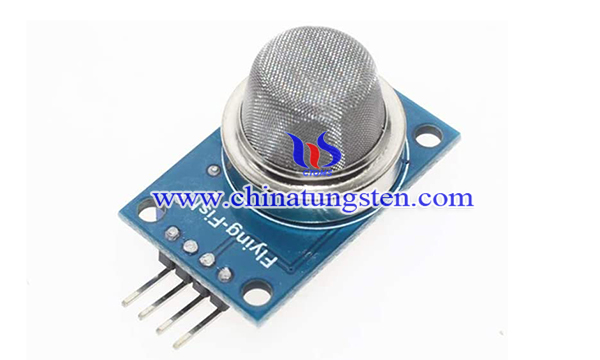Preparation of WO3/Co Nanoparticles for Gas Sensing
- Details
- Category: Tungsten Information
- Published on Thursday, 28 October 2021 22:35
Due to global industrial growth and increased emissions of particular gases (such as NO2, H2S or VOC), indoor and outdoor air quality monitoring has become a major issue today. These gases in sufficiently high concentrations bring a negative effect to the environment and human healthy.
Therefore, scientists have prepared tungsten trioxide /cobalt oxide nanoparticles (WO3/Co) for gas sensing using W(CO)6 and the metal-organic precursor Co(acac)2. The sensors tested show very good repeatability and good long-term stability. The preparation process is as below:

The AACVD methodology was employed to grow, on top of alumina transducers, a first layer of pristine tungsten oxide. Some of the layers grown underwent a second AACDV process to be loaded with different concentrations of cobalt oxide nanoparticles. The first step consisted of the synthesis of pure WO3 nanowires employing 50 mg of W(CO)6 as precursor. Such precursor was solubilized in a mixture of methanol and acetone with a 1:3 vol ratio. The solution was sonicated until all the precursor material was fully solved and then, was placed in an aerosol generator, which used a bath and ultrasonic waves to convert the solution into a micro-droplet spray that contained the precursor. This spray is conveyed via a connecting pipe system using nitrogen as an inert carrier gas at a flow of 1 L/min towards a 400 °C preheated CVD hot-wall reactor where the substrates are placed. Typically, the process for growing tungsten oxide samples took 20–30 minutes to complete and is run at atmospheric pressure. With this procedure and considering the reactor dimensions, up to 3 samples can be produced at the same time. The commercially available alumina substrates employed have interdigitated platinum electrodes screen-printed on the front side and a platinum heating resistor printed on the backside. Three of these substrates placed and kept face up in the reactor chamber during and AACVD process. The resulting tungsten oxide nanowire layers fully coat the electrode are of the substrates. Such layers have a dark-blue color, which is indicative of tungsten oxide being highly oxygen sub-stoichiometric and that some amorphous carbon residues left by the organic precursor and solvents are present. To remove such impurities and enhance oxidation, an annealing step is performed right after the deposition, which is conducted in a muffle at 500 °C for 2 h, with a temperature ramp of 5 °C/min, under pure dry air. After this step, the films show a green-yellowish color, indicative that a slightly oxygen defective tungsten oxide is achieved.
In conclusion, WO3/Co nanoparticles for gas sensing has been prepared using W(CO)6 and the metal-organic precursor Co(acac)2. The result showed that the presence of cobalt oxide nanoparticles clearly had a positive influence in enhancing responsiveness to ethanol (80% increase) and hydrogen sulfide (60% increase). Co-loading at low levels also had a positive effect for achieving remarkable selectivity towards ammonia. In addition, Cobalt oxide-loaded tungsten oxide is well suited for detecting ammonia under dry conditions and hydrogen sulfide in humid environments.
- Tungsten Oxide Manufacturer & Supplier, Chinatungsten Online: www.tungsten-oxide.com
- Tungsten News & Prices of China Tungsten Industry Association: www.ctia.com.cn
- Molybdenum News & Price: news.molybdenum.com.cn
- Tel.: 86 592 5129696; Fax: 86 592 5129797; Email: sales@chinatungsten.com



 sales@chinatungsten.com
sales@chinatungsten.com